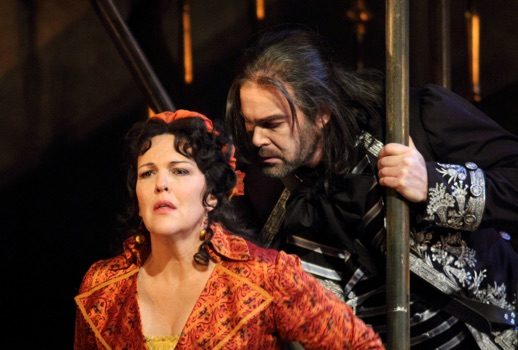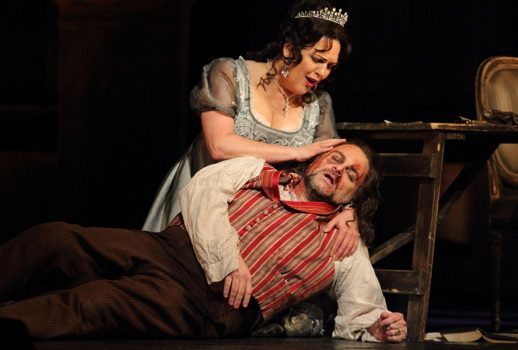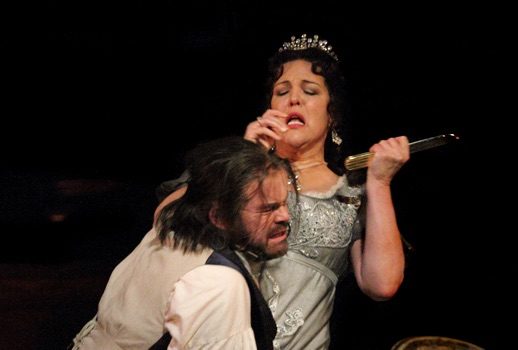

Opera, too, has its sledgehammers. Elektra doesn’t send you out of the theatre with a spring in your step. But operatic tragedies, especially Puccini’s, tend towards the tearjerker side of things.
It’s perhaps because Puccini is the master of operatic pathos that Tosca has proved so hard for people to get a handle on. We all know what a certain critic said about the opera in 1956. Like the observation a certain singer made about Il Trovatore, it’s become a shorthand for discussion of the opera. But Kerman’s shabby little shocker of a description has gained a weird power over the years.
It used to be that people would quote it dismissively, as if to say “how could anyone get it this wrong?” But gradually, insidiously, it’s almost begun to seem as if it’s the first responsibility of any production to defend the work against Kerman’s claim. The very qualities that make Tosca a repertory staple—its set pieces, its masterful control of tension, its sure dramatic impetus—almost seem to have become sticks to beat it with. “It just works,” we sneer, as if there were no worse charge to be laid against a piece of theatre.
At the root of it is genre snobbery, of course, because Tosca is neither a tearjerker nor a sledgehammer. It’s that most disrespected of all entertainments, a thriller. Despite the moments of pathos—”why do you reward me thus?’,” “my dream of love has vanished for ever!”—there’s never really any more urge to sob our hearts out at the end of Tosca than there is at the end of Rear Window.
It’s this, I think, that is at the root of Kerman’s distaste—“How dare an opera try to keep me on the edge of my seat?—and this may also be the reason why traditionally its been an opera that has tended towards lavish treatment from directors and designers. LOOK AT THIS MASSIVE PRETTY CHURCH! WHAT A BEAUTIFUL RED DRESS! YES I KNOW IT’S ALL RAPE AND STABBINGS BUT HEY, CASTLE! An emphasis on grandeur, to de-emphasise the grubby human instincts behind both the plot and our appreciation of it.
The success of Jonathan Kent’s Royal Opera House production, new in 2006 and revived for the twelvety-nth time, is that, while it looks glorious enough to satisfy the most die-hard traditionalist (sets and costumes by the recently departed and greatly missed Paul Brown) it doesn’t hide the toughness of the work under opulence.
Like all good Toscas, it’s at its best in the second act because like all good thrillers, Tosca spends its central section ramping up the stakes to the point where something has to explode. What this production emphasises is how fast everything happens: Tosca arrives from doing her job and within literally minutes she somehow finds herself bargaining for her lover’s life.
Act two was also the strongest section of Adrianne Pieczonka’s performance. Because she isn’t, temperamentally, one of the flashing-eyed grandezza kinds of Tosca, what we got instead was a clear idea of how fast this woman’s mind is racing. She panicked, improvised: “Nel pozzo del giardino” tumbled out of her mouth instinctively and without calculation.
There was no sense of Playing The Character, with the result that, for example, “Vissi d’arte” became something personal and internal, a genuine prayer rather than a set piece. The sarcastic slow handclap from Gerald Finley’s Scarpia, surely directed as a response to the production’s original Tosca, Angela Gheorghiu, seemed out of place after something so non-performative.

The much-discussed “Ma falle gli’occhi neri’ was in this performance much more of a shared joke against herself than an imperious demand; similarly, when Finley’s Scarpia provided the “evidence” of Cavaradossi’s infidelity, Pieczonka was deeply hurt rather than glittering with furious rage.
If I had to choose a single word to describe the character Pieczonka created, it would be “likeable,” not a word one would typically associate with this part.
Tosca as a real person! It’ll never catch on…
What were missing from Pieczonka’s performance were the moments of demented abandon that, with the best will in the world, really are required at two specific points- the murder of Scarpia and the discovery that Cavaradossi is dead. Her strength in nuance was balanced by a weakness in letting go; both moments were generically “operatic” and not entirely convincing.
And, maybe it’s cheap of me, but a hands-by-sides hop over the edge of Castel Sant’Angelo doesn’t cut it. I want outstretched arms and a backwards fall at the very least.
As previously mentioned, Pieczonka is very good vocal nick indeed. The middle of the voice has the beauty one would expect of a singer who specializes in Strauss, and while there’s the tiniest touch of squall at the top of the voice, it’s an attractive loosening rather than a shriek.
Her amplitude and volume would be enough to satisfy the most demanding of size queens and it’s just such a goddamn healthy sound. It’s fun to hear a Tosca who is fully vocally entitled to the part, rather than just getting through it on guts and hope.
Vocal entitlement was perhaps more of an issue with the other two principals. In lyrical mode, Joseph Calleja has one of the most purely beautiful tenor voices I’ve ever heard. To these ears (ears which are about to be deafened by howls of angry protest) the timbre is reminiscent, when unstressed, of Bjorling or Gigli. There’s nobody I’d currently rather hear as, for example, Rodolfo.
But a great Rodolfo isn’t always a great Cavaradossi, and Calleja lacks the elemental, force-of-nature power for the big moments. A tentative, first-nightish “Recondita armonia” had lovely touches early on but at the climax of the aria the voice became so covered that it seemed to disappear into the throat rather than open up into the house.

(Before we leave Cavaradossi, I think I’m done with the subtext version of act 3, by the way. I want to see a production where he really believes he’s going to escape with Tosca, because I have a hunch it would be more moving, and a hunch it would fit the, you know, actual music better. But mainly I’m just bored with the fact it’s always done the same way now. This Cavaradossi even screws up and throws down the safe conduct before Tosca’s had a chance to explain what happened).
Finley is, as we all know, incapable of giving a bad performance but I’m not altogether sure Scarpia—which he was singing for the first time—is his part. This production gives him a massive, Beyoncé-in-Vegas entrance, twin followspots picking him out at the top of a centre-stage staircase, and conductor Dan Ettinger cranking up the LOUD and the SLOW on Scarpia’s motif to the point where anything less than Titta Ruffo with a megaphone would have been a disappointment—but there’s no denying that Scarpia is a size or two too big for this voice.
Finley is an excellent actor and a wonderfully scrupulous, detailed singer. The suave, controlled psychopath he created was all the more chilling for the matter-of-fact way he described his sadistic urges, both in soliloquy and to Tosca. His “Ebbene?” and “La Regina farebbe grazia ad un cadavere” were caressed with a sinister, lieder-singer’s delicacy. On HD his performance will be pretty close to ideal. But in the house Scarpia becomes, in a metatheatrical kind of way, a lot less scary when we constantly hear his voice being swamped by the orchestra.
Some of this is doubtless due to Ettinger, who didn’t seem singer-friendly all night. In addition to the moments where the orchestra drowned the singers (even, at one point, the huge-voiced Pieczonka) he often seemed to be trying to take Calleja way slower than the tenor wanted to go, and while he certainly whipped up some dramatic sounds, he always seemed to prioritise the flashy over the simple.
The supporting cast was strong both vocally and dramatically, especially the Spoletta of Aled Hall and Jihoon Kim’s Sciarrone. And to the Shepherd Boy who suffered an unfortunate sudden attack of puberty during “Io de’sospiri”, all I can say is bad luck, lad. I survived the Once In Royal David’s City Incident of 1985, you’ll get over this.
But despite these gripes, it all worked which, despite what the Kermans of the world would have you think, is not an insult. After the nailbiting of the second Act, the third rushed inexorably to its inevitable conclusion in the satisfying way it always does and of COURSE there were goosebumps at the end, because why wouldn’t there be?
This wasn’t one of the great nights at the opera but then, as many have pointed out, the great nights need by definition to be few and far between. It was, however, a notably intelligent production of a hard-to-cast opera featuring three singers who are probably among the best in the world, if not necessarily the best in the parts they were playing.
It was an honest, classy, quality evening of the kind every opera house wishes it could produce on a routine rep night. And if that sounds like faint praise, it’s not meant to be.
Photos: Catherine Ashmore

























Comments